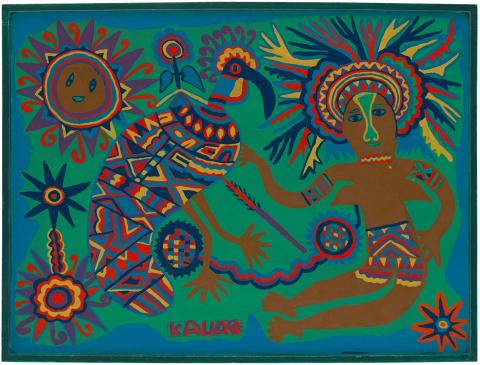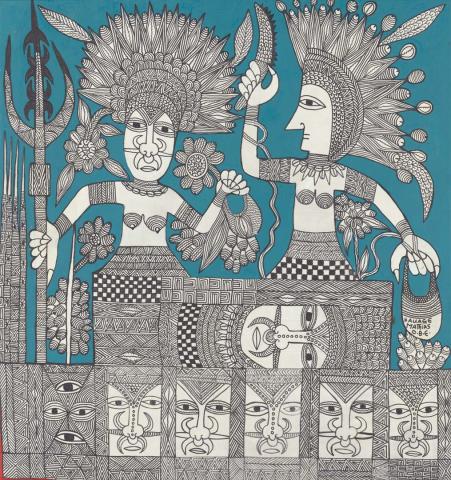Mathias Kauage
'Kin' July 2022
The bold and bright paintings of Mathias Kauage have inspired generations of artists in Papua New Guinea. Kauage hailed from the Highlands region, had no formal artistic training and was working as a cleaner at the University of Papua New Guinea, Port Moresby, when he attended an exhibition of drawings by Timothy Akis in 1969. Inspired by what he saw, Kauage made contact with English-born artist Georgina Beiers (1938–2021), who was living and working in Port Moresby at the time, and the two commenced a lifelong working relationship and friendship.
From the outset, Beiers and her husband Ulli (1922–2011) provided Kauage with materials and artistic direction, supporting him to work and exhibit in National Art School’s gallery. During the 1970s Kauage’s work quickly evolved from early drawings of village life and fantastic creatures, inspired by Chimbu myth, to scenes of life and events in the rapidly expanding Port Moresby. Embracing colour and humour, Kauage went on to produce major paintings that often commented on aspects of colonial history and his own experience. As Kauage’s reputation grew, he was able to support family and clan members to move to Port Moresby, where he gathered a small circle of younger artists around him whom he supported, at times by signing his name on their works so they could sell. This group of followers became designated as pikinini bilong Kauage (children of Kauage). In some cases, Kauage even adopted young artists, as happened with the talented orphaned painter Chris Kauage.
Initially, many of these artists imitated Kauage’s work, but as their confidence grew, they began to develop their own individual styles and voices, adapting and extending his distinctive tropes. Among those who have perpetuated his legacy in compelling new ways are Kauage’s wife, Elisabet Kauage, and his son, John Kauage.
Connected objects

Independence celebration 1999
- KAUAGE, Mathias - Creator

Marbles 1988
- KAUAGE, Mathias - Creator

Kiapten Kuk Ship 2002
- KAUAGE, Elisabet - Creator
Related artists
KAUAGE, Mathias
1944
- 2003
Full profile
for KAUAGE, Mathias
KAUAGE, Elisabet
1951
- 2024
Full profile
for KAUAGE, Elisabet


